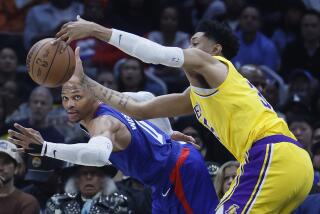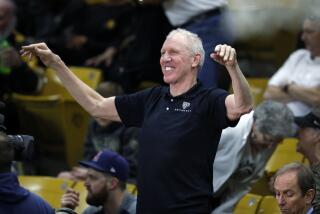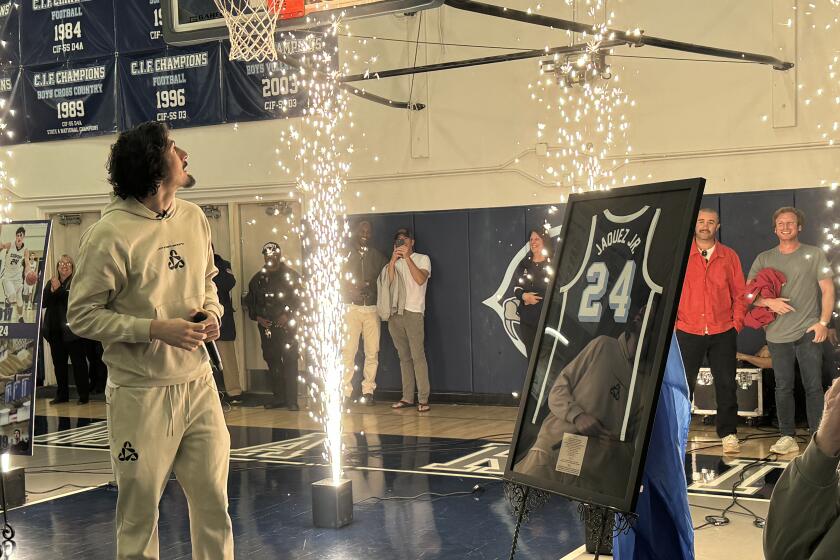This Wooden Caught the Moment but Then It Got Him : Orange Bowl: Irish defender made big play against Florida State before injury changed his career.
MIAMI — In one moment, he woke up the echoes of the Four Horsemen, Knute Rockne and the Gipper. In the next, it was as if he had been crushed by the weight of more than a century of Notre Dame football history. Or the Golden Dome.
It is no wonder that in the team’s 1995 press guide, when asked what he had learned since arriving four years before at Notre Dame, Shawn Wooden said, “Everything does not always go the way you expect it to.”
Florida State Coach Bobby Bowden could have told him that even before the crisp, windy afternoon of Nov. 13, 1993, at South Bend, Ind., where the No. 1 Seminoles and the No. 2 Irish matched 16-game winning streaks. Spike Lee was there for Florida State, Phil Donahue for Notre Dame. They were joined by 59,073 more fans, some of whom paid as much as $1,000 for tickets to see what was advertised as “The Game of the Century.” As it turned out, that might not have been hyperbole.
It was not as dramatic as the upcoming Fiesta Bowl game between first- and second-ranked teams, Nebraska and Florida, because it did not come at the end of the season, but it was close enough--the 10th game for each--that Bowden could almost feel his palms around his first national championship trophy.
Little could he have imagined that it would, at least temporarily, slip through them because of the play as time ran out made by Wooden, a sophomore reserve defensive back from outside Philadelphia with a reconstructed back and a suspect knee.
More than two years later, as Wooden prepares to meet the Seminoles again as a senior starting cornerback Monday night in the Orange Bowl, he still is not sure that he has recovered physically from that play and its consequences but is certain that he is a more complete person because of it.
“You never know what’s going to happen from one moment to the next, especially in a game like football,” he said last week. “That’s the way it is in life too. The sooner you learn that lesson, the better you become.”
The Seminoles had a chance until Wooden stepped in front of the would-be winning touchdown pass, although it did not appear for most of the game that they would.
Notre Dame Coach Lou Holtz, who usually carries a black cloud with him to ward off sunny days, was upbeat before the game, quoting Dwight D. Eisenhower to his team, and, with two weeks off to prepare for Florida State, devised a game plan that included everything but the Statue of Liberty play.
Senior punter-flanker Adrian Jarrell, who had carried the ball only three times in his career, scored the first touchdown on a 32-yard reverse pitch, and All-American safety Jeff Burris switched to running back for two more as the Irish took leads of 24-7 and 31-17.
But the Seminoles came back behind the passing of quarterback Charlie Ward, driving 45 yards in 99 seconds to pare the lead to seven with 1:39 remaining.
That was when Wooden made the play that he thought had clinched the victory by recovering Florida State’s on-side kick. After five other players piled on him in an attempt to steal the ball, he limped off the field with what he assumed was a sprained right knee.
Notre Dame trainer Jim Russ met him at the sideline and asked if he could return to the game if necessary. “I hoped I wouldn’t have to, that the offense could run out the clock,” Wooden said last week. “But I told him that I could. The adrenaline was pumping, and I didn’t feel that much pain.”
Three plays and a partially blocked punt later, Wooden and the Irish defense were on the field again, hoping that Ward could not take the Seminoles 63 yards in the final 51 seconds. He took them 49 yards in 48 seconds. From the 14 with three seconds remaining, he had one play to get them into the end zone for a chance at the two-point conversion and a victory.
Ward later would say that he should have thrown the ball underneath to open wide receiver Matt Frier at the five-yard line, but Wooden said that three Irish defenders were closing on Frier and would have stopped him before he scored. “Charlie made the right choice,” Wooden said.
The choice was to throw the ball into the end zone toward tailback Warrick Dunn. Wooden, playing the deep zone in a prevent defense, got there first, slapping the ball out of the air.
“It was the best moment of my career,” Wooden said, “followed closely by the worst.”
What followed was a celebration by the Irish players. When linebacker Justin Goheen leaped onto Wooden’s back, he knocked the defensive back to the ground. Pain again shot through his left knee.
Six days later, Wooden underwent arthroscopic surgery to repair the torn cartilage suffered in the injury on the on-side kick. He watched on television as Notre Dame lost to Boston College, a startling turn of events that led to Florida State winning the national championship after all. Notre Dame finished where it started on Nov. 13, as No. 2.
Wooden tried to return in time for the Cotton Bowl game against Texas A&M;, but the knee remained too painful. Within a week after the season ended, doctors discovered that he had suffered a more severe injury to his left knee, a tear of the anterior cruciate ligament, in the celebration after the Florida State game and ordered reconstructive surgery.
Wooden, unable to play his second season at Notre Dame after major back surgery, missed spring practice in 1994, and although he returned to play the next season, he did not feel 100% recovered until this fall. Even now, he wonders whether he has regained the quickness he had before and realizes that will be a factor when pro scouts evaluate him.
“They’re going to look at the fact I’ve had two surgeries and wonder,” he said.
But he knew that two years ago and, as a result, began putting more emphasis on education. He received his degree in computer science engineering last May and plans to attend law school.
“It slaps you in the face when you know football is not going to be in your life as long as you want it to be,” he said. “I’d like to play until I’m 50, but I know that’s not possible. I might not even play again after this game.
“But I wouldn’t change a thing. If I could go back in time and decide to stay on the bench for the last four plays of the Florida State game, I wouldn’t do it. I wouldn’t trade the play I made for anything. I’ve become part of Notre Dame history.”
More to Read
Go beyond the scoreboard
Get the latest on L.A.'s teams in the daily Sports Report newsletter.
You may occasionally receive promotional content from the Los Angeles Times.










